Living in Pennsylvania and saw some big birds but are not sure which ones they were?
Pennsylvania is known for its avifauna. According to the Pennsylvania Ornithological Records Committee (PORC), there are over 430 species of birds there! And just like in Florida, Michigan, Ohio, Colorado, Illinois, and Texas, plenty of those can grow up to impressive sizes.
Examples of large birds in Pennsylvania include the great horned owl, peregrine falcon, black vulture, wild turkey, osprey, bald eagle, tundra swan, and many others.
The largest bird in Pennsylvania is the mute swan with a wingspan of up to 94 inches, a length of up to 67 inches, and a weight of over 26 pounds.
Some of these giant birds, like the great horned owl and black vulture, can be seen year-round in the state, while others, like the peregrine falcon and bald eagle, will spend only winter there.
Here are their photos, sizes, and fun facts – from the smallest to the largest bird.
Table of Contents
Large Birds In PA
1. Peregrine Falcon

- Scientific name: Falco peregrinus
- Lifespan: 12-15 years
- Length: 13–23 in
- Wingspan: 29–47 in
- Weight: 0.7-3.3 lb
- Range In Pennsylvania: Winter resident in eastern PA
Peregrine falcons are the largest falcons found in Pennsylvania. These large raptors are famous for their flying speeds and can reach 200 mph (similar to the speed of a race car)!
In the early 19th century, Pennsylvania had around 44 peregrine falcon nests; by the middle of the century, they were completely extirpated from the state (due to the use of pesticides). Thanks to strong conservatory efforts, peregrine falcons recovered and were removed from the state’s threatened and endangered species list in 2021.
Peregrine falcons measure 13-23 inches long, weigh 0.7-3.3 pounds, and have a wingspan of 29-47 in. Similar to other raptor species, females are around 30% bigger than males. Identify Peregrine falcons by their grayish backs, long wings that reach tail tips, and powerful yet slender builds.
Most peregrine falcons can be seen in PA during winter months; some adults will stay in the state year-round. In Pennsylvania, these large falcons will nest on buildings and bridges and lay 2-5 creamy white eggs per year.
The pairs are monogamous, stay together for life, and use the same nesting site year after year.
Although mostly silent, they will emit loud and harsh “ka-yak” and “kek-kek” calls. Using their speed, keen sight, and sharp talons, peregrine falcons can strike and capture birds in mid-air. They will soar at great heights and dive down at 200 mph to grab the prey. Besides birds, these falcons also hunt small mammals, reptiles, and even insects.
2. Great Horned Owl

- Scientific name: Bubo virginianus
- Lifespan: 15-25 years
- Length: 17-25 in
- Wingspan: 35.8-60.2 in
- Weight: 2.7-3.5 lb
- Range In Pennsylvania: Year-round resident throughout PA
Also known as tiger owls, great horned owls are the most famous and the biggest owls in Pennsylvania. They are also among the largest owls in North America and live in mountains, grasslands, conifer forests, deserts, chaparrals, and many other habitats.
Great horned owls have the most diverse diet of all North American raptors. Aggressive and excellent hunters, these big birds feed on rabbits, hares, rats, mice, voles, other small mammals, larger mid-sized mammals, reptiles, amphibians, and invertebrates.
They might occasionally even attack large birds, including raptors such as ospreys, bald eagles, peregrine falcons, prairie falcons, and other owls. They hunt using their acute hearing and excellent eyesight and can fly in near silence to catch their prey by surprise.
In case you see great horned owls in person, you will notice long, earlike tufts, intimidating golden yellow eyes, and a deep hooting call. They also have gray-brown plumage with a mottled pattern and a white patch at the throat. These large night owls are monogamous and pairs may stay together for over five years, sometimes even for a lifetime.
3. Rough-legged Hawk
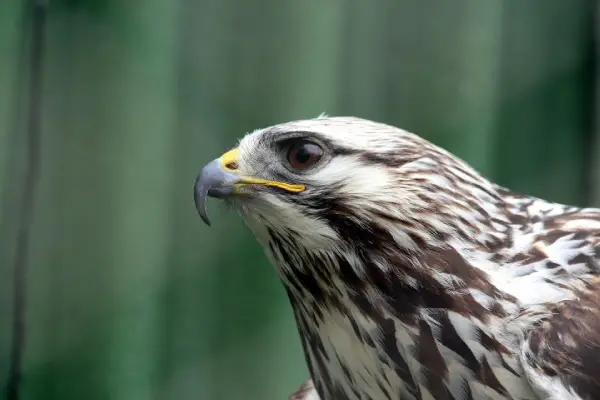
- Scientific name: Buteo lagopus
- Lifespan: 15 years
- Length: 18-24 in
- Wingspan: 47-60 in
- Weight: 1.3-3.6 lb
- Range In Pennsylvania: Winter resident throughout PA
Rough-legged hawks or rough-legged buzzards are large birds of prey found in Europe, Asia, and North America. Females are bigger than males and weigh from 2.3 to 3.6 pounds; males are 1.3 to 2.2 pounds heavy.
Rough-legged hawks are the second largest hawks found in Pennsylvania and can be seen during winter throughout the state. During their non-breeding season, these long-winged raptors are common in open country, around large open fields and marshes.
Rough-legged hawks come in different morphs. Light morphs have pale plumage with dark bellies and dark “wrist” patches while dark ones are brown-black with white flight feathers.
They were named after their feathered legs that help keep them warm in the Arctic regions. They also love to hover by beating their wings quickly, just like kestrels, osprey, and kites.
Rough-legged buzzards have small talons which might explain why they mostly hunt small mammals.
They have an interesting adaptation for locating their prey – rough-legged hawks use UV vision to hunt.
Some small mammals, like voles and mice, leave trails of urine as they move. Those urine trails reflect ultraviolet light – rough-legged hawks see them glowing bright yellow which helps them locate their next meal and highlight hunting areas with high prey densities.
They nest in trees and cliffs, lay 1-7 bluish-white eggs with brownish spots, and males feed the females as they incubate the eggs – the species are monogamous.
4. Black Vulture

- Scientific name: Coragyps atratus
- Lifespan: 10 years in the wild
- Length: 22–29 in
- Wingspan: 52-66 in
- Weight: 3.5-6.6 lb
- Range In Pennsylvania: Year-round resident in Southeastern PA
Pennsylvania is home to two vulture species: black vultures and turkey vultures – black vultures are most common in the southern counties.
These large and aggressive black raptors can be identified by their naked black heads, chalky white feet and legs, and white wing patches that can be seen during flight. Both sexes look similar.
Black vultures have been increasing their presence in Pennsylvania and can be seen in southeastern parts of the state year-round. According to Breeding Bird Surveys, they have seen a 10% annual increase in their populations between 1966 and 2009 there.
People often mistake them for turkey vultures; the main difference is the bigger size and wider wings and tails in turkey vultures. In addition, black vultures flap their wings more frequently when flying.
Black vultures are highly gregarious birds and might form large communal roosts at night that can often include turkey vultures. They are carnivores and primarily feed on carrion; black vultures may also hunt and eat small reptiles, birds, and mammals. They will spend most of their day looking for food.
To escape from danger, these large black birds in Pennsylvania will regurgitate partially digested food to distract the attacker and become lighter before flying away. Black vultures are monogamous and pairs are believed to mate for life – both the male and female will take turns incubating their eggs.
Black vultures are protected under the Migratory Bird Treaty Act and you can’t kill them without a permit.
Read More: List of birds singing at night in Pennsylvania
5. Great Egret
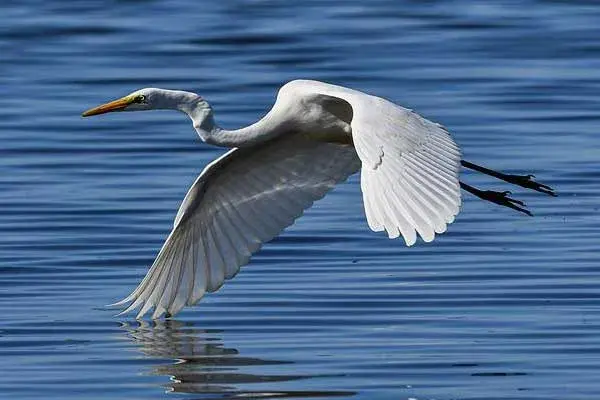
- Scientific name: Ardea alba
- Lifespan: 22 years
- Length: 31-41 in
- Wingspan: 52-67 in
- Weight: 1.5-3.3 lb
- Range In Pennsylvania: Breeding resident in Eastern PA
Great egrets are the largest of the four white herons found in Pennsylvania.
Despite not being considered to be threatened species nationwide, Pennsylvania lists them as endangered and protected under the Game and Wildlife Code. Since 2009, they have been mostly nesting in York County (Kiwanis Lake) and in Dauphin County (the Susquehanna River’s Wade Island).
These impressively large birds have a wingspan of up to 5 ft 7 in and a weight of up to 3.3 lbs. They are white and have long black legs and enormous yellow-orange beaks (4.2-5.3 inches long) that they use for hunting.
In North America, great egrets almost become extinct in the 19th century as people were extensively hunting them for their beautiful plumes called “aigrettes” which were used as a hat decoration. Thanks to several laws and conservational measures, their numbers have since recovered.
Similar to pelicans because of their white plumage, great egrets can also tuck their necks right into their backs during flight. They are seasonally monogamous (stay with the same partner for one breeding season) and breed in colonies in trees close to large lakes.
To attract a female, a male great egret will display its mating season plumage and colors and point its beak upward. Great egrets will slowly stalk their prey or stay motionless, waiting for the right moment to strike and impale prey with their long, sharp bills. They consume fish, frogs, small mammals, small reptiles, crustaceans, and insects.
6. Great Black-backed Gull

- Scientific name: Larus marinus
- Lifespan: up to 27 years
- Length: 25–31 in
- Wingspan: 59-66.9 in
- Weight: 1.65-5 lb
- Range In Pennsylvania: Winter resident in Southeastern PA
Often described as “kings of the Atlantic waterfront”, great black-backed gulls are very aggressive hunters, pirates, and scavengers.
They are the largest gulls in Pennsylvania and can be seen in southeastern parts of the state during winter. Great black-backed gulls are present all year in most parts of their northern breeding range and when the winter comes, some populations will migrate south.
You will recognize these enormous gulls by their white heads, necks and underparts, dark grey wings and backs, pink legs, and yellow beaks. Because of their size and omnivorous feeding habits, these gulls will prey on other birds during the nesting season.
Great black-backed gulls feed on carrion, fish, mollusks, crustaceans, marine worms, insects, rodents, and berries. They are apex predators that also eat adults, young, and eggs of other birds.
Great black-backed gulls were hunted for their feathers that were used to make hats in the past. As a result, this species got eradicated from large parts of its range. Today, however, due to their adaptability to humans, the great black-backed gulls increased in numbers and became widespread – in some areas they are now even considered pest species.
7. Wild Turkey
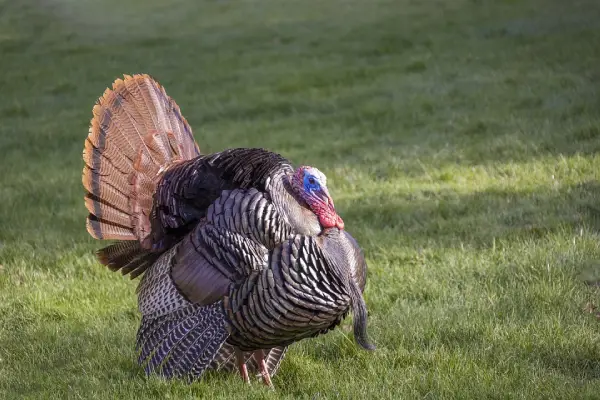
- Scientific name: Meleagris gallopavo
- Lifespan: 3-5 years in the wild
- Length: 30-49 in
- Wingspan: 49.2-56.7 in
- Weight: 5.5-24 lb
- Range In Pennsylvania: Year-round resident throughout PA
After peaking in 2001, Pennsylvania’s wild turkey population has been decreasing. They went from 280,000 to around 159,000 birds in 2021. Some of the possible reasons include habitat loss, diseases, and hunting.
Wild turkeys are native to North America and are considered to be ancestors of domestic turkeys. They are the main course on Thanksgiving and Benjamin Franklin called them “a true original native of America.”
Wild turkeys are permanent residents of PA, found statewide around the woods and mountains. There are 5 subspecies and the one found in Pennsylvania is the eastern wild turkey (M. g. silvestris).
Wild turkeys are among the largest in North America and can be identified by their large bodies, long legs, and small heads. They are mostly brown and males have red wattles on their throats and necks.
Adult males called toms usually weigh 11 to 24 pounds; females (hens) are smaller and weigh 5.5–11.9 pounds. According to the National Wild Turkey Federation, the heaviest wild turkey ever recorded weighed 37.1 pounds!
These enormous birds have good eyesight and hearing and prefer to stay hidden. Wild turkeys are most known for the gobble call (ll-obble-obble-obble) males use to attract females.
8. Osprey

- Scientific name: Pandion haliaetus
- Lifespan: 15-20 years
- Length: 19.7-26 in
- Wingspan: 50–71 in
- Weight: 2-4.6 lb
- Range In Pennsylvania: Summer resident in Southern PA
Ospreys had a tough history in the state. In 1979, they were listed as extirpated in Pennsylvania, and in 1986, there was only one known nesting pair in the state. Thankfully, they have since recovered with a reported 115 osprey nests in 21 PA counties in 2010.
These large raptors have been also removed from Pennsylvania’s list of threatened species in 2017.
Ospreys begin arriving in Pennsylvania around late March and early April to nest and leave the state to migrate south in August, September, and October, with most migrating birds leaving around mid-September.
They are dark brown above, and white below, with M-shaped wings when soaring, white heads, and a broad brown stripe through the eyes. Due to their small white heads, wide wingspans, and sharp beaks and talons, people sometimes mistake them for bald eagles.
These large diurnal birds of prey can be found around lakes, rivers, and swamps. Ospreys have several vocalizations: a slow whistled “kyew-kyew” guard call and a short clear whistle “cheereek” alarm call. They are piscivorous and fish makes up 99% of their diet, hence their nickname “fish hawks.”
They will hover above the water, locate their prey and then swoop down for capture with their talons extended. Their toes are covered with short spines which help them grasp slippery fish better. During their 20-year-long lifetime, these migratory birds can travel over 160,000 miles!
Ospreys nest near water, on top of dead trees, and use branches, sticks, twigs, moss, and fish bones as material. The female will lay a clutch of 3 eggs that both partners incubate.
9. Turkey Vulture
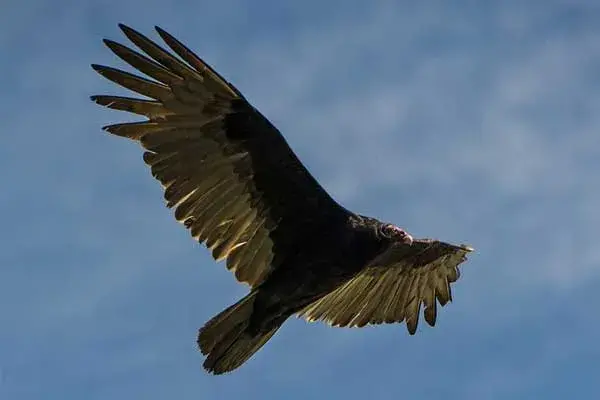
- Scientific name: Cathartes aura
- Lifespan: 16 years
- Length: 24-32 in
- Wingspan: 63-72 in
- Weight: 1.8-5.3 lb
- Range In Pennsylvania: Throughout PA
Turkey vultures are huge black-colored raptors and the most widespread of the New World vultures. Also known as turkey buzzards or just buzzards, they were named after their resemblance to wild turkeys.
With a wingspan of around 6 feet, black-brown plumage, bare red heads, and white legs, turkey vultures are hard to miss in the sky. Look for their silvery flight feathers that are contrasted with dark wing linings while they fly. They are one of the largest raptors in the USA, just after the eagles and condors.
Turkey vultures are more common and widespread than black vultures in Pennsylvania and can be seen statewide. Some northern populations will migrate south for the winter.
They are common in open habitats and can be seen around urban and suburban developments, farmlands, and forested areas.
Using their keen vision and sharp sense of smell, turkey vultures can locate carrion easily. They lack a syrinx (the vocal organ) which makes them voiceless; all turkey vultures can do is hiss, whine, and grunt.
They are very social birds that roost in large community groups with several hundred individuals. You might also spot them sitting in trees on the sides of roads waiting for their next meal.
They do a great service across the US by removing dead animals and preventing the transmission of any diseases those dead animals could have carried. Because of their extremely strong stomach acids, turkey vultures can eat and digest carcasses tainted with anthrax, tuberculosis, and rabies, without getting sick.
10. Canada Goose

- Scientific name: Branta canadensis
- Lifespan: 10-24 years
- Length: 30-43 in
- Wingspan: 50-73 in
- Weight: 5.7–14.3 lb
- Range In Pennsylvania: Year-round resident throughout PA
Before 1935, Canada geese did not nest anywhere in Pennsylvania; today, these enormous birds are common in every county.
With a 6 ft wingspan, 3.5 ft length, and weight of over 14 pounds, Canada geese are the largest goose species found in Pennsylvania. There are 7 subspecies of Canada geese – the largest of them, the giant Canada goose (B. c. maxima), is the only one that breeds in the state.
These ridiculously large birds are commonly found around wetlands, parks, fields, and golf courses; you will identify Canada geese by their brown color above that is paler below, black necks and heads, white cheeks, and black bills and legs.
Canada geese are considered a nuisance in the state for eating field crops, feeding upon golf course greens and lawns, attacking people to defend their nests, or leaving droppings on lawns, athletic fields, and parks.
Canada geese mostly breed between February and April and have a clutch size of 4 to 10 eggs that females incubate. They are also known for flying in a distinctive V-formation and series of loud “honk” calls.
11. Sandhill Crane
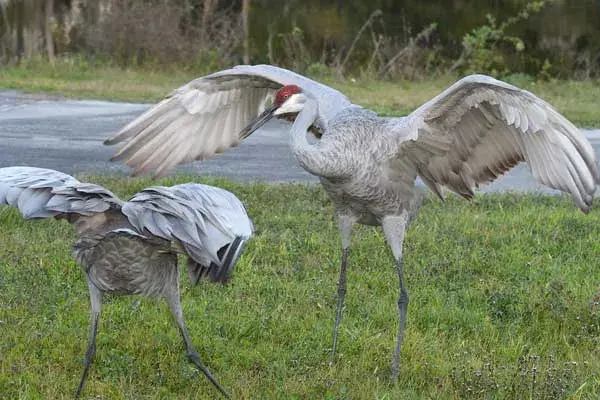
- Scientific name: Grus canadensis
- Lifespan: 20 years
- Length: 47.2 in
- Wingspan: 78.7 in
- Weight: 6-14.8 lb
- Range In Pennsylvania: Breeding resident in Northern PA
Sandhill cranes have been increasing in numbers in Pennsylvania – going from just a few sightings in the 1980s to being spotted in more than 30 counties today. From October to November 2017, a Pennsylvania Game Commission survey found 170 sandhill cranes, 72 more than the first survey in 2013.
Sandhill cranes are one of the tallest and the most striking birds in Pennsylvania. They measure almost 4 feet in height, span almost 7 feet across the wings, and weigh almost 15 pounds.
You will recognize them by their mostly slate gray plumage, rusty washes on the upperparts, pale cheeks in adults, red patches on their heads, and black legs. These extremely tall birds also have long necks and legs, and very broad wings.
Sandhill cranes are summer residents in northern parts of PA, usually found around fields, prairies, the edges of swampy areas, lakes, and marshes.
These migratory birds start arriving around late February and after breeding, move south from late September to late November. Sandhill cranes are fairly social birds and can be usually found in pairs or family groups throughout the year.
They are also monogamous and mate for life, staying together for years, until one of the cranes dies. Sandhill cranes mostly feed on plants, insects, and snails.
12. Great Blue Heron

- Scientific name: Ardea herodias
- Lifespan: 15 years
- Length: 36–54 in
- Wingspan: 66–79 in
- Weight: 4-7.9 lb
- Range In Pennsylvania: Year-round resident throughout PA
One of the biggest blue-colored birds in the world, great blue herons are permanent residents of Pennsylvania. They are also the largest herons native to North America and can be found around marshes, ponds, lakes, flooded fields, swamps, and river shorelines.
With a wingspan of up to 6.6 ft, these blue-winged birds are hard not to see. Great blue herons are blue-gray and have large yellow-orange beaks, short black plumes on their heads, and black and chestnut patterns on the shoulders. During the flight, they will hold their neck in an S-shape with legs trailing behind.
Great blue herons are monogamous only for a single season and will go through some interesting courtship rituals, locking and rubbing their bills on the feathers of the other bird before mating. Both parents will take turns in incubating the eggs. They nest in colonies called heronries that can occasionally have more than 500 nests!
Great blue herons are carnivores that feed on fish, amphibians, reptiles, invertebrates, small mammals, and even other birds. These wading birds will slowly stalk their prey in shallow waters, striking with lightning speed, and catching them with their long and sharp beaks.
13. Bald Eagle
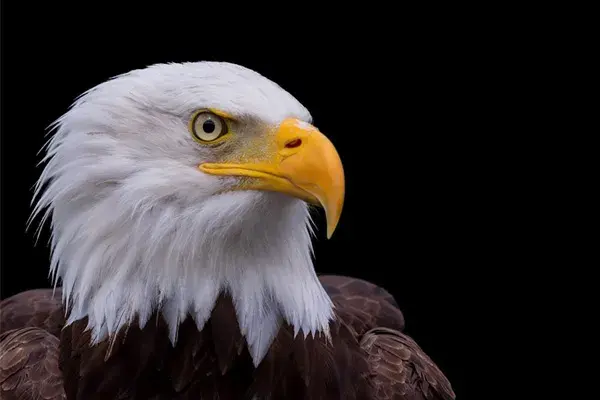
- Scientific name: Haliaeetus leucocephalus
- Lifespan: 20-30 years in the wild
- Length: 28-40 in
- Wingspan: 70.8-90.5 in
- Weight: 6.6-13.9 lb
- Range In Pennsylvania: Winter resident throughout PA
Bald eagles are the largest eagles in Pennsylvania. They range from 28 to 40 inches long and have a wingspan of up to 7 feet 7 inches.
These large raptors were selected in 1782 to be the national symbol of the United States and can be identified by their brown bodies, white heads and tails, and yellow legs and beaks. Before attaining these characteristics around the age of five, bald eagles are mostly dark brown with varying amounts of white mottling.
Bald eagles are protected under the Game and Wildlife Code in Pennsylvania. The state’s bald eagle population has been steadily increasing, going from 3 pairs in 1980 to more than 270 pairs in 2013.
These magnificent raptors can be first spotted in the state around December and stay there until March; they are most common along rivers or near lakes with large trees.
Bald eagles build one of the largest nests of any North American bird – the largest recorded one was in Florida and measured 10 feet wide and 20 feet deep. These magnificent raptors are hard to miss as they soar through the air with their 7.5-foot-wide wingspan. Bald eagles are carnivores and opportunistic feeders that primarily consume fish they snatch from the water with their sharp talons.
14. Tundra Swan
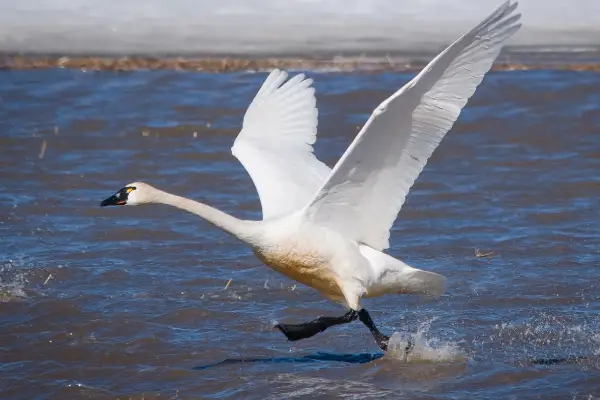
- Scientific name: Cygnus columbianus
- Lifespan: 10 years
- Length: 45–59 in
- Wingspan: 66-83 in
- Weight: 7.5-21.2 lb
- Range In Pennsylvania: Winter resident in southeastern PA
Tundra swans are the second largest birds in Pennsylvania. They migrate across the state around spring and fall with some populations wintering in the southeastern parts.
These huge white birds with long necks, black beaks and legs, dark eyes, and yellow “teardrops” in front of the eyes can weigh as much as 21.2 pounds! Males and females look alike.
Tundra swans, as the name suggests, breed in the tundra of the Arctic and subarctic and can be found around shallow pools, lakes, and rivers. Around September, they will migrate to winter grounds on the Pacific coast (from Vancouver Island to Northern California and from southern Idaho to southern Colorado river) and around the eastern Great Lakes and the mid-Atlantic coast.
Tundra swans are the most numerous of the North American swans and are nicknamed “whistling” because of the sound their wing flapping produces. They become very aggressive and territorial during the breeding season; in other parts of the year, tundra swans are rather social birds.
They are monogamous, mate for life, and build nests near lakes and other open waters that both parents construct. The female will incubate 4-5 eggs while the male helps; both parents will raise the young. Tundra swans are omnivores and mainly feed on aquatic plants and roots, some arthropods, worms, and shellfish.
Read More: What are some examples of large Virginia birds?
15. Mute Swan

- Scientific name: Cygnus olor
- Lifespan: up to 10 years in the wild
- Length: 49-67 in
- Wingspan: 79-94 in
- Weight: 18.7-26.2 lb
- Range In Pennsylvania: Year-round resident in eastern PA
Mute swans are the largest birds in Pennsylvania. They measure from 55 to 63 inches long (in some extreme cases can reach 67 in), weigh over 26 pounds, and span from 79 to 94 inches across the wings.
These enormous swan species were introduced to PA and were named “mute” for being less vocal than other swan species. Regardless, they still produce a variety of hisses and other sounds.
Identify mute swans by their all-white plumage, orange beaks with black borders, and pronounced knobs on top of their beaks. While swimming, mute swans will keep their necks curved and wings raised; when resting, the necks are curved like a letter S and the beaks are pointed downwards.
Mute swans are permanent residents of the state and can be seen around ponds and lakes where they feed on submerged aquatic vegetation, crustaceans (crayfish, shrimp), fish, and aquatic insects.
These aggressive, territorial, and invasive swans will fight with native trumpeter swans, pushing them out of their nesting area. Due to their large numbers and negative effect on other waterfowl and vegetation, they are now considered invasive species.
Mute swans are monogamous and males will also incubate the eggs. Male swans are called “cobs”, females “pens”, and young are “cygnets”.
Read More: Examples of large birds in Wisconsin
Summary
This concludes our list of big birds in Pennsylvania. There are plenty of eagles, swans, owls, and herons that grow to immense sizes and that can be found in the state. We hope you found this article interesting.
Also, feel free to read our guide on nocturnal animals in PA